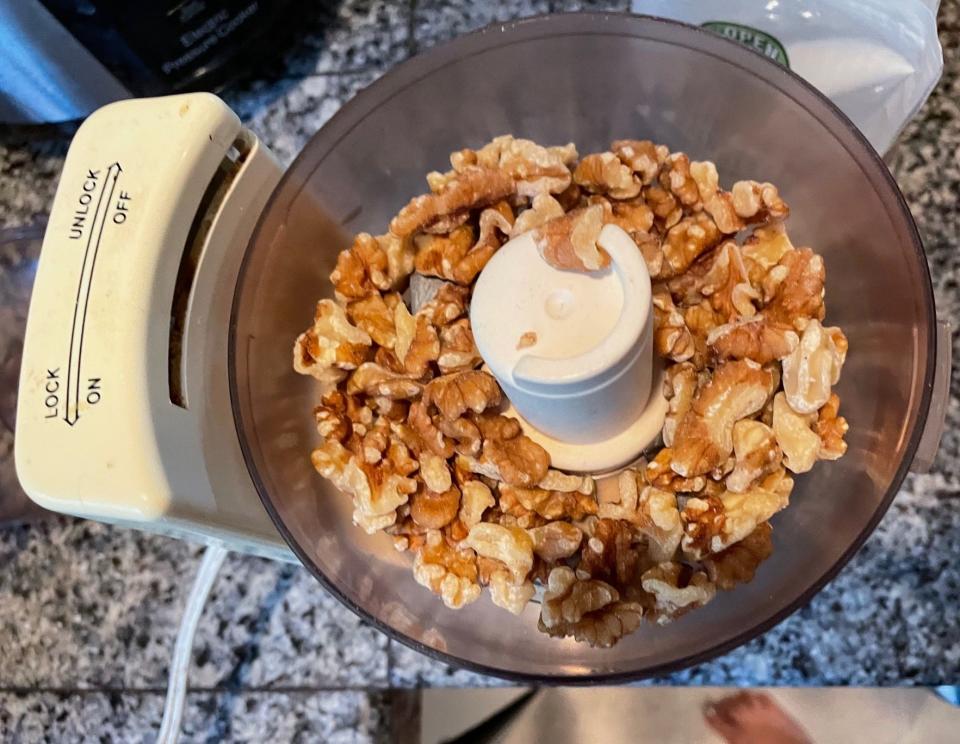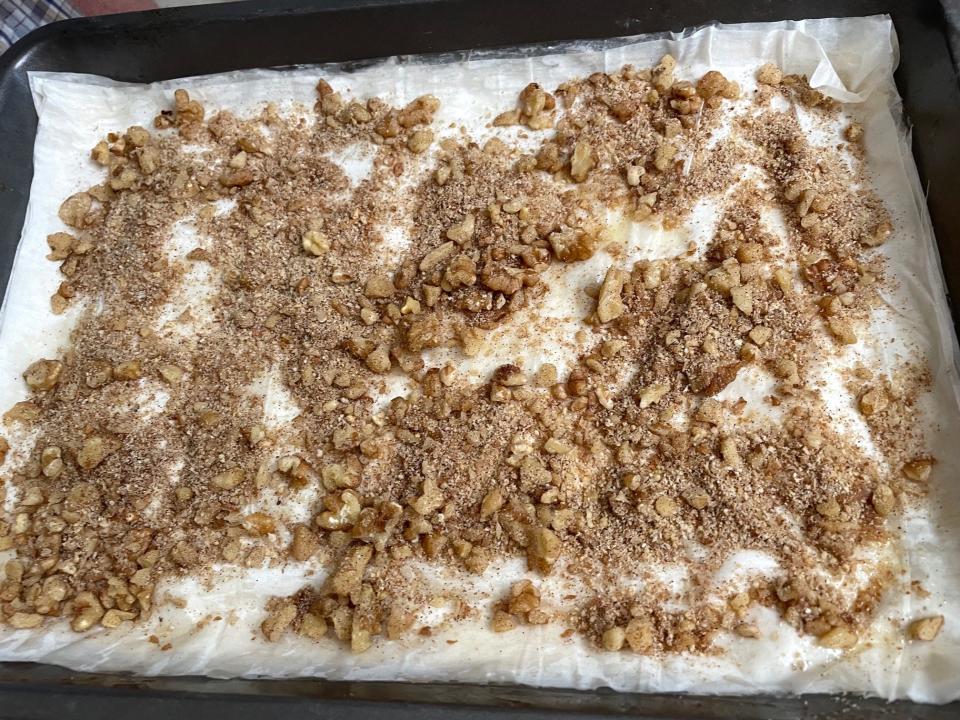My dad's easy Greek baklava recipe has been in our family for generations. Here's how to make it.

My Greek grandfather was a phyllo maker, and his baklava has been in my family for generations.
My dad makes baklava every Christmas and showed me how it's done.
The recipe isn't as intimidating as it seems, and it will impress everyone during the holidays.
Baklava has always been an important part of my family's history.
My pappou — Greek for grandfather — was a phyllo maker, and my dad grew up watching him make baklava and kataifi at his store, Φύλλο κρούστα ΚΩΝΣΤΑΝΤΙΝΙΔΗΣ, in Thessaloniki.
According to family lore, my pappou actually helped invent frozen phyllo. Why I'm not a frozen phyllo heiress partying with Paris Hilton on a yacht in Mykonos, I do not know, but I'm still proud!
Our family makes my pappou's baklava every Christmas, so I asked my dad to finally share its history and recipe with the world.
Here's how to make it.
My pappou had a flyer he gave his bakery's customers with a hilariously short baklava recipe.

My dad told me that my pappou started giving people the flyers — which also included recipes for Greek treats like trigona and galaktoboureko — because they were constantly asking how he made them.
His baklava recipe is less than 70 words and basically translates to: "We add breadcrumbs and a bit of sugar in the mix. We lay the phyllo in layers of two. We add the mix in multiple layers, not just the middle."
My dad started selling baklava at the bakery when he was 12 years old.

During the holiday season, my dad would always help my pappou at the store. But he didn't start making the dessert himself until he moved to the US, wanting to continue the tradition while more than 6,000 miles away from his entire family.
Like my dad, every Christmas memory I have includes baklava. It doesn't feel like the holidays without it. And since my dad taught me how to make his famous pastitio and avgolomeno soup, it was only natural that baklava would be next on the list.
And, lucky for you, he was more than happy to share the family recipe — and prove that baklava is a lot easier to make than it looks.
My dad's baklava only requires a few ingredients, and you probably already have most of them in your kitchen.

To make my dad's baklava, you'll need:
1 packet of phyllo dough
2 sticks of unsalted butter
2 cups of chopped walnuts
2 cups and 2 tablespoons of sugar
½ cup of plain breadcrumbs
1 tablespoon of cinnamon
My dad always begins by melting the butter in a saucepan over low heat.

"As Paul Hollywood would say, you need good lamination," my dad told me sagely as he watched to ensure the butter didn't burn.
He also throws his walnuts into a food processor — but just for a few seconds.

"You don't want them to be a powder," he told me.
No food processor? No problem. My dad said it's also perfectly fine to roughly chop your walnuts with a knife or buy pre-chopped walnuts from the supermarket.
Then, it's time to prepare the baklava mixture.

We added the walnuts to a large bowl with 2 tablespoons of sugar, as well as the cinnamon and breadcrumbs.
My dad told me that breadcrumbs help the baklava absorb the syrup better, a helpful trick that was actually discovered by accident.
"Walnuts in Greece used to be very expensive, and people would cheat with breadcrumbs," he said. "But they found that the breadcrumbs actually really help with absorption."
Just make sure the breadcrumbs are plain — no Italian seasoning!
Then, give the bowl a quick mix.

As the scents of cinnamon and walnuts twisted together, I felt like I could already smell the baklava.
It brought me back to being a kid, where I'd walk by the kitchen every Christmas break and watch my dad dutifully prepare this mix.
Before you can begin building the baklava, you need to prep your phyllo.

No one expects you to make your own phyllo — this isn't "The Great British Bake-Off." But make sure to leave your phyllo in the fridge for a day or two before you make the baklava. It can't be used frozen.
It's also important to cut the sheets before building the baklava.

My dad's pro tip is to take your pan (he recommends using one that's medium-sized and has a rectangular shape) and place it over the sheets. Then, using a sharp knife, cut the phyllo to almost match the size of the pan.
"It's OK to fold a little phyllo on the side, so give yourself some extra dough," my dad said. "But you don't want a huge amount."
And don't throw anything away. Those extra phyllo strips are going to come in handy later.

Make sure you save some of your best sheets for the bottom of the baklava (you need a strong base) and the top (so it looks extra impressive).
It's time to build those layers! My dad always begins by brushing some butter on the bottom of his pan.

You don't need much; just a thin layer will do.
Then, start by placing two layers of phyllo in the pan.

As you build the baklava, you always add two phyllo sheets at a time and brush the second layer with a little butter.
"Not too much," my dad said. "It doesn't have to be soaked, or else the baklava will be very oily."
After six total layers of phyllo, throw in some walnut mix after adding the butter.

"Sprinkle the whole pan with a thin layer of your mix," my dad said. "And put a bit more of the mix around the middle of your phyllo."
"But you don't want areas where there's no filling," he added. "You want some in every bite."
You'll continue repeating those three simple steps as you build more and more layers of the baklava.

Remember, the breakdown is:
Two layers of phyllo at a time, the top brushed with butter
Every six layers of phyllo, add some of the walnut mixture
When you reach the middle of your pan, start using the extra phyllo strips.

Place the strips next to each other, as we did above, to mimic a full sheet and get the most out of your box of phyllo. Just make sure you're still doing two layers at a time.
"It's not an arts and crafts project; it's food!" my dad said. "You're not going to see any of this when you cut the baklava, just multiple layers of phyllo."
The middle is also where you'll want to put a bit more of the walnut mixture.

And if you end up missing the count and accidentally put three layers of phyllo instead of two or the walnuts on top of layer seven instead of six, my dad said it's "not the end of the world."
"The key is you just want to make laminated layers with the filling," he added. "Don't panic, and do the best you can."
The last two layers should be your best layers.

For this pan of baklava, we actually did four final layers instead of six since we ran out of phyllo.
If you want, you can always make more mix. And if you have extra phyllo, you can use it to make tiropitakia (cheese pies) or spanakopita (spinach pies) and really turn this into a Greek feast.
Make sure to cover your entire last layer with butter.

This is why you want to use full sheets of phyllo on top — it's very hard to butter broken layers.
And don't forget to butter the edges. My dad says this will help protect the phyllo from burning.
Before throwing your pan in the oven, you need to cut the baklava.

Before baking, use a sharp knife to cut the baklava into small triangles or squares.
"If you don't cut it, the baklava will not cook," my dad told me. "Raw baklava is not good. Plus, it's very hard to cut after you cook it because the baklava is very flaky."
My dad recommends using the diagonal cut.

It helps the cooking process, and it's the traditional shape. First, cut the baklava into squares, then slice them diagonally.
You'll want to bake the baklava at 350 degrees Fahrenheit until golden brown.

My dad said the baking time will take 45 to 55 minutes. Every oven is different, so check on yours until you get that beautiful color.
Now, it's time to make the syrup.

To begin the syrup, mix the 2 cups of sugar with 1 cup of water.
Then, add a bit of lemon juice to the mix.

My dad told me that lemon juice helps prevent the syrup from crystallizing, which makes the baklava last longer.
Then mix the syrup as you wait for the first boil.
"Wait a few seconds after it starts boiling, then take it off of the heat," my dad said. "Don't let it boil for more than a minute."
While the syrup is still hot, pour it all over your cold baklava.

My dad recommends using a ladle for this step and says it's important to pour the syrup evenly over the baklava.
It's also important to note that your baklava needs to cool completely before adding the syrup. My dad usually lets the baklava sit overnight, but he said you can just wait a couple of hours if you're in a crunch for time.
Then, cover your pan with aluminum foil and let it rest for 30 minutes.

This helps the baklava absorb all that delicious syrup.
The baklava is ready to serve once it's cold.

To make sure the syrup doesn't crystallize, my dad says it's important to always use a clean knife when you're cutting new pieces and always avoid using a wet knife or wet utensils.
Also, there's no need to refrigerate. You can let your pan sit out in the kitchen for days (if it's not eaten before then!).
And if your baklava tastes anything like my dad's, it will be absolutely delicious.

There are so many incredible textures and flavors that dance together as you bite into a piece of baklava. You've got the flakiness from the phyllo, combined with that sweet, sticky syrup. And then there's that satisfying crunch of the walnuts in the middle, bringing everything together as it melts in your mouth.
I brought some of my dad's baklava on a road trip with friends years ago, and they still talk about it to this day. My boyfriend and his roommates said it was so good it gave them goosebumps.
This recipe has won my dad baking contests at his office and has been the talk of every Greek holiday party we've ever attended.
I'm telling you, this is the real deal.
This baklava may be my family's recipe, but I know it'll bring you joy for years to come.

The most special thing about food to me has always been the stories it can bring. My pappou passed when I was 4 years old, but I've been able to keep a connection with his spirit through the baklava that my dad has made every Christmas. And now that I can make it as well, it's a tradition I know I'll always honor.
While I know it can seem intimidating, my dad's recipe proves that you don't have to be a Greek phyllo maker (or the descendant of one) to make some amazing baklava for your family and friends.
So, whether you only make this baklava once or it earns a permanent spot on your family's holiday menu, I hope you feel the love in this recipe.
Read the original article on Business Insider


